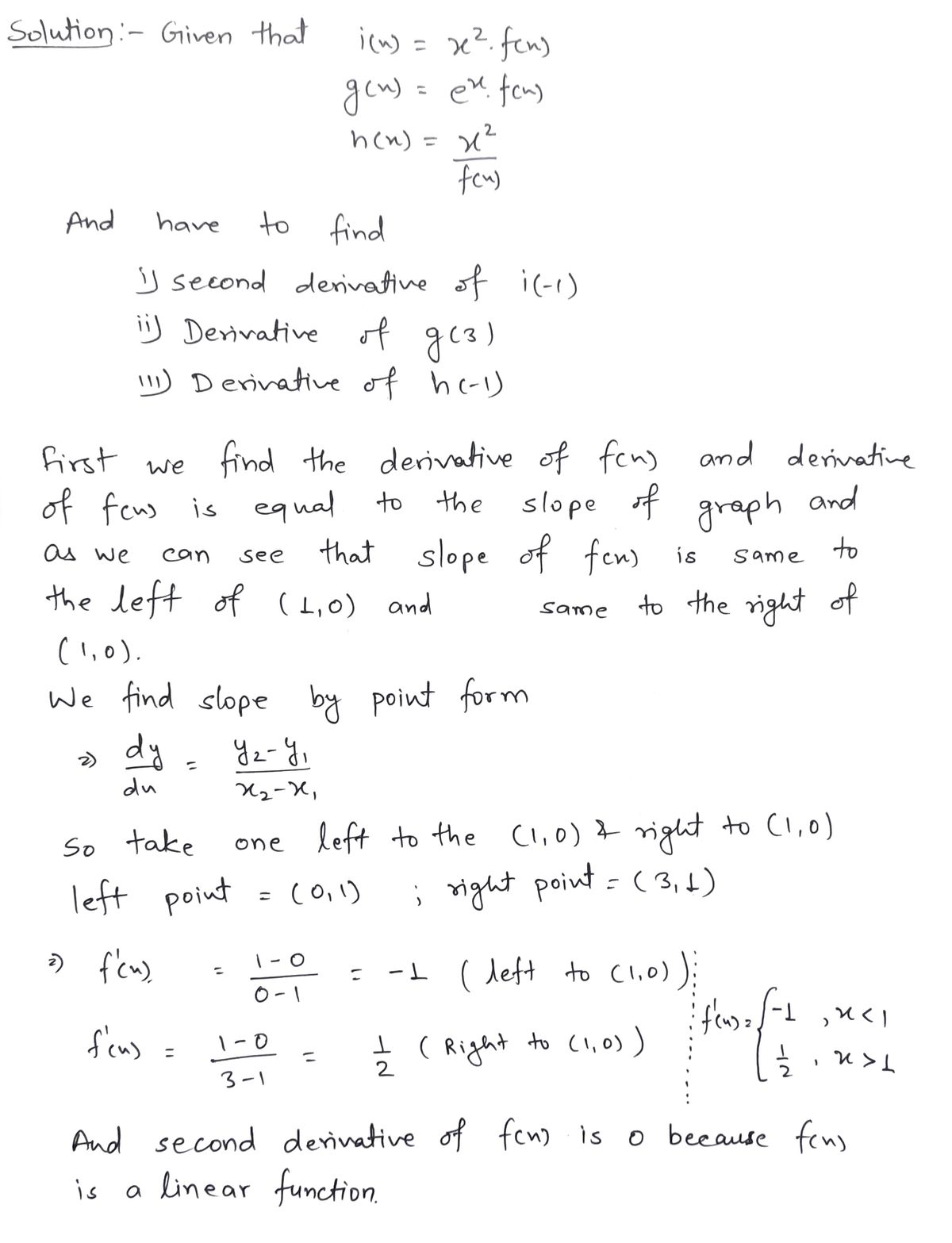-what is the second derivative of i (-1) when i(x) =x^2f(x) -What is the derivative of g(3) when g(x) = e^xf(x) - what is the derivative of h (-1) when h(x)= x^2/ f(x)
-what is the second derivative of i (-1) when i(x) =x^2f(x) -What is the derivative of g(3) when g(x) = e^xf(x) - what is the derivative of h (-1) when h(x)= x^2/ f(x)
Calculus: Early Transcendentals
8th Edition
ISBN:9781285741550
Author:James Stewart
Publisher:James Stewart
Chapter1: Functions And Models
Section: Chapter Questions
Problem 1RCC: (a) What is a function? What are its domain and range? (b) What is the graph of a function? (c) How...
Related questions
Topic Video
Question
-what is the second derivative of i (-1) when i(x) =x^2f(x)
-What is the derivative of g(3) when g(x) = e^xf(x)
- what is the derivative of h (-1) when h(x)= x^2/ f(x)

Transcribed Image Text:The image displays a graph of the absolute value function, \( f(x) = |x| \).
### Description of the Graph:
- **Axes:**
- The horizontal axis is labeled as \( x \).
- The vertical axis is labeled as \( f(x) \).
- **Plot:**
- The graph has a V-shape, originating at the point (0, 0), which is the vertex of the graph.
- For \( x < 0 \), the graph is a straight line with a negative slope, moving downward from left to right. It reflects the linear function \( f(x) = -x \).
- For \( x > 0 \), the graph is a straight line with a positive slope, moving upward from left to right, representing the linear function \( f(x) = x \).
- **Points and Intersections:**
- The graph intersects the y-axis at the origin (0, 0).
- It intersects the x-axis at two points: (-2, 2) and (2, 2), indicating the value of the absolute function as 2 in both directions.
This graphical representation highlights the basic characteristics of the absolute value function, showing how it reflects over the y-axis and demonstrates symmetry.
Expert Solution
Step 1

Step by step
Solved in 2 steps with 2 images

Knowledge Booster
Learn more about
Need a deep-dive on the concept behind this application? Look no further. Learn more about this topic, calculus and related others by exploring similar questions and additional content below.Recommended textbooks for you

Calculus: Early Transcendentals
Calculus
ISBN:
9781285741550
Author:
James Stewart
Publisher:
Cengage Learning

Thomas' Calculus (14th Edition)
Calculus
ISBN:
9780134438986
Author:
Joel R. Hass, Christopher E. Heil, Maurice D. Weir
Publisher:
PEARSON

Calculus: Early Transcendentals (3rd Edition)
Calculus
ISBN:
9780134763644
Author:
William L. Briggs, Lyle Cochran, Bernard Gillett, Eric Schulz
Publisher:
PEARSON

Calculus: Early Transcendentals
Calculus
ISBN:
9781285741550
Author:
James Stewart
Publisher:
Cengage Learning

Thomas' Calculus (14th Edition)
Calculus
ISBN:
9780134438986
Author:
Joel R. Hass, Christopher E. Heil, Maurice D. Weir
Publisher:
PEARSON

Calculus: Early Transcendentals (3rd Edition)
Calculus
ISBN:
9780134763644
Author:
William L. Briggs, Lyle Cochran, Bernard Gillett, Eric Schulz
Publisher:
PEARSON

Calculus: Early Transcendentals
Calculus
ISBN:
9781319050740
Author:
Jon Rogawski, Colin Adams, Robert Franzosa
Publisher:
W. H. Freeman


Calculus: Early Transcendental Functions
Calculus
ISBN:
9781337552516
Author:
Ron Larson, Bruce H. Edwards
Publisher:
Cengage Learning